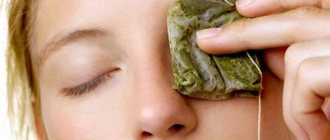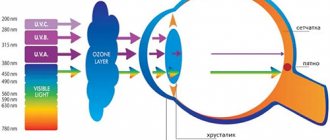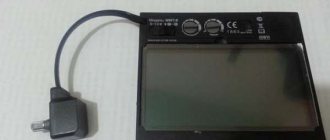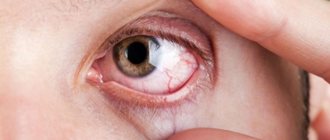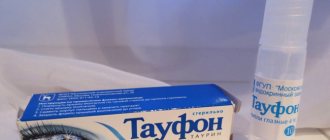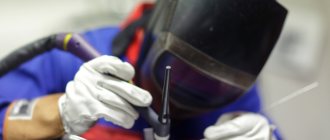Characteristics and types of eye burns
According to statistics, approximately 10% of ophthalmic injuries are burns. At the same time, about 70% of victims receive burn injuries at work, and the remaining 30% - at home.
Essentially, an eye burn is damage to the cornea, eyeball, and other structures of the eye due to physical or chemical exposure. Depending on what caused the injury, there are several types of burns:
- chemical - when the damaging factor is aggressive chemicals;
- thermal - occurs when the eyes are exposed to hot air, liquid, steam, open fire;
- radiation - damage from ultraviolet, infrared rays or other types of radiation;
- combined - combines several damaging factors.
Taking into account the degree of eye damage, the burn can have 4 degrees. With the mildest, first, redness of the conjunctiva and skin of the eyelids occurs, swelling and superficial erosion of the cornea may develop.
In the second degree, the upper layers of the skin of the eyelids are damaged, burn blisters appear on it, and the epithelium and the underlying substance of the cornea are damaged.
A third degree burn injury is often indicated by severe clouding of the cornea - a burn in such a situation can even lead to the development of cataracts. Some of the tissues of the conjunctiva, sclera, and eyelid die, and the damage affects no more than half of the eyeball.
The most severe, fourth degree, is characterized by deep necrosis or charring of tissue. Often the patient develops uveitis, glaucoma, and perforation of the cornea.
There are also different types of burn injuries based on the location of the lesion: burns of the conjunctiva, cornea, eyelids, and periorbital zone.
Any burn to the eye area requires immediate first aid.
What does it mean to “catch welding bunnies”?
For your information! The tissues of the eye (in particular, the retina) are designed for certain light loads, exceeding the level of which can lead to burns.
In nature, such a high level of illumination is characteristic only of the sun, but since in ordinary situations no one consciously looks at it directly and without eye protection, sunburn of the retina is considered a rarity.
For welders, burns of the retina, conjunctiva and cornea are considered occupational diseases, and their severity directly depends on the length of service and intensity of work, as well as on the brightness of the electric arc.
First aid for a chemical burn to the eyes: what to do before the ambulance arrives?
In case of a chemical burn to the eyes, it is important to provide assistance immediately, without waiting for an ambulance to arrive. If the damage occurs as a result of exposure to an alkali, acid or other chemical, the first step is to clean the eye of any remaining substance. To do this, you should start rinsing as quickly as possible. In such a situation, speed plays a decisive role and can determine the degree of burn and the prognosis of recovery.
Rinsing the eye should be done under running water, generously moistening a piece of cotton wool and wiping the eyeball towards the nose with it. If the burn occurs as a result of exposure to alkali, a two percent solution of boric acid can be used for rinsing. If the eye tissues are affected by acid, a soda solution is suitable for rinsing. However, ophthalmologists do not recommend using these solutions without first consulting a doctor, because unexpected reactions of damaged tissues may occur. Therefore, until the ambulance arrives, you can limit yourself to clean water. In case of a chemical burn, you need to rinse your eyes for at least 10-15 minutes.
Ophthalmologists note that if a powdered chemical gets into the eyes, it is necessary to remove its remnants from the eyes with a dry cotton swab before rinsing.
After removing the remaining chemical substance from the eyes, you can drip a 4-5% solution of novocaine, lidocaine or another anesthetic into the eyes, and give the victim a drug with an analgesic effect.
Also, first aid for a chemical burn to the eyes includes instillation of drugs to prevent infections. The emergency doctor will tell you which remedy is best to use.
Let's sum it up
Unfortunately, even a professional is not immune from getting an eye burn. The first symptoms are pain, itching, and a feeling as if hot sand had been poured into the eyes. In most cases, the injury is accompanied by swelling. After providing first aid, you should definitely visit a doctor because you may have burned your retina.
In general, following safety precautions and carefully checking the integrity of protective equipment immediately before work prevents such accidents. If you follow these seemingly simple rules, you won’t have to wonder what to do if your eyes hurt from welding. After all, health is the most precious thing we have, and the least we can do for it is to take care of it.
Ultraviolet eye burn: first aid rules
A burn of the cornea by ultraviolet light is called electroophthalmia. It often occurs in people who work with welding or are exposed to ultraviolet sun for a long time (for example, when skiing without a protective mask).
The peculiarity of an ultraviolet burn is that the first symptoms may appear only 6-10 hours after the injury.
First aid for ultraviolet eye burns is thorough rinsing with water or saline, instilling moisturizing drops and moving the victim to dark or low light conditions. You can also use sunglasses for this.
Anesthetics can be used briefly to relieve pain. But it is better to first consult with an emergency doctor, since such drugs slow down the healing process of the cornea. Cold compresses can help relieve pain without the use of medications.
To protect against infection, it is recommended to use antibacterial ophthalmic ointments.
An ultraviolet eye burn, if first aid is provided on time, is often a reversible condition and goes away without a trace within a few days. Moreover, electroophthalmia is easily prevented with preventive measures. For example, welders must use special protective masks when working, and skiers must wear ski goggles with high UV protection before skiing.
Traditional medicine
If an accident does occur, it will most likely manifest itself at home.
Therefore, it is not always possible to promptly visit a doctor. You should know how you can help the patient at home. In fact, there are many folk remedies that are used for burns. So a compress of chamomile infusion constricts blood vessels and has a calming effect. Pour boiling water over 2 tablespoons, after 10 minutes moisten cotton pads and place on eyes. There are many different folk methods for treating eyes after welding. You can treat your eyes with honey. A certain amount of honey (by eye) is dissolved in warm water until a sweet solution is obtained. Soak cotton swabs and place them on the victim's eyelids. Helps with swelling after welding work.
Thermal burn of the cornea of the eye - treatment before the ambulance arrives
If you or another person has a thermal burn to the cornea of the eye, treatment should begin with eliminating the damaging factor. The injury site should then be thoroughly cooled. Most often, cold tap water is used for this purpose, and rinsing is carried out from the outer to the inner corner of the eye. You can also rinse the visual organs using a rubber bulb, a syringe without a needle, and other devices that can provide sufficient water pressure.
As a last resort, you can use a saucepan or other container with water. Having immersed your face there, you need to blink frequently for 20 minutes.
After cooling, an antiseptic drug (for example, a solution of chloramphenicol or albucide) is dripped into the eyes. If the pain is severe, the patient is given painkillers.
Symptom Signs
Signs of burns (or “bunnies”) are:
- sensation of the presence of a foreign body or sand under the eyelids in the eyes;
- feeling of itching, burning and irritation;
- for minor burns – discomfort similar to symptoms of eye fatigue;
- headaches that worsen with eye movement;
- the appearance of spots of light before the eyes .
With such symptoms, the victim must provide first aid and consult an ophthalmologist, who will determine the severity of the lesion and prescribe appropriate treatment if necessary.
Is it necessary to go to the hospital to treat burns?
Sometimes after first aid is provided, the victim feels much better and decides not to go to the hospital. However, ophthalmologists strongly recommend that in case of any burn injuries, immediately call an ambulance or independently take the victim to the hospital, where he will be prescribed further therapy.
Such recommendations are explained by the fact that eye burns have several stages of development, which can cause difficulties in diagnosis. Sometimes, on the first day, symptoms of a mild burn are observed, and after a couple of days, irreversible changes in the cornea and other tissues of the eye occur, up to the complete loss of its functions.
That is why, after providing emergency care, it is necessary to urgently take the patient to the nearest ophthalmological hospital, where his condition can be monitored and promptly corrected by professional doctors.
Possible consequences
In case of serious welding burns and lack of adequate treatment and first aid, the following complications may develop:
- disruption of the shape of the lens and cornea , which leads to astigmatism;
- irreversible corneal opacities;
- corneal erosions and ulcerations;
- decreased visual acuity;
- with severe burns of the cornea - complete loss of vision .
Application of drops
One of the most effective ways to get rid of bunnies after welding is to use eye drops. The most effective ophthalmic solutions for instillation, acceptable for electroophthalmia:
- Anti-inflammatory . These include Nimesil and Indomethacin. Helps relieve inflammation and pain.
- Vasoconstrictors . These drops include Visin and Visoptin. It is recommended to use several times a day until the symptoms of welding bunnies are completely eliminated. Should not be used for more than three days without a doctor's prescription.
- Antibiotics in drops . These products make it possible to relieve inflammation, disinfect and accelerate tissue restoration. Used only with a doctor's prescription. The most commonly prescribed drugs are Gentamicin and Tobramycin.
- Anesthetics . The most unpleasant symptom after a welding burn is severe pain, redness and irritation. Therefore, it is impossible to do without the use of anesthetics. The most effective are Lidocaine and Tetracaine.
Any remedies for bunnies after welding must be used after examination by a doctor. Only a specialist can select the most effective drops, their combination, the required dosage and course of treatment.
Prevention
Burns to the eye cornea as a result of electric welding can be prevented if maximum attention is paid to compliance with the most important personal safety rules. When using a welding machine, be sure to wear properly selected safety glasses or a mask.
All work equipment must be in good working order and thoroughly checked. It is under no circumstances recommended for strangers to look at welding work, as this can cause burns. Welders should take breaks and give their vision proper rest.
Causes of painful eye sensations from welding sparks
Corneal tissue allows and absorbs ultraviolet radiation. If you look at them without protective equipment, damage to the corneal tissue occurs. A short beam can even reach the retina, causing injury. Long waves have a weaker effect on the body, causing virtually no damage to the eyes.
However, even if you follow all the rules for working with equipment, you need to know what to do from welding bunnies. Symptoms most often do not begin to appear immediately, but after a certain time. The cornea has nerve endings, so the first symptom is severe pain. The sensation may resemble a grain of sand damaging the eye, but the pain is much worse.

